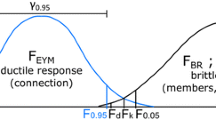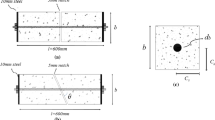Abstract
Owing to its forgiving tolerances and eliminating the need for welding, grouted dowel in-conduit connections are widely used for connecting various precast concrete elements, for instance in precast wall construction and bridge bent cap systems. Current design recommendations for such a connection treat it similar to a conventional reinforcing bar-in-concrete and do not account for the restraining effect of the duct. In the present study, a series of experimental and analytical approaches have been adopted to explore the disparity between grouted dowel connections and bar-in-concrete. The experimental program consisted of testing twenty-four pull-out specimens under monotonic loads. The main parameters investigated included the embedment length, concrete compressive strength and corrugated duct. Results from the experimental and analytical procedures showed that grouted dowel in-conduit connections behave markedly different from bars in concrete. Different failure mechanisms occurred in the grouted connections due to the confinement effect of the duct. Moreover, an increase in load carrying capacity and ductility of the connections was observed at all embedment lengths, regardless of the concrete compressive strength. Based on the experimental findings, an analytical model for predicting the embedment length of the connection was derived, calibrated and proven to be more accurate than state-of-the-art design procedures.













Similar content being viewed by others
References
ACI Committee 318 (2014) ACI 318-14: building code requirements for structural concrete and commentary
Einea A, Yamane T, Tadros MK (1995) Grout-filled pipe splices for precast concrete construction. PCI J 40(1): 82–93
Raynor DJ, Dawn EL, Stanton JF (2002) Bond-slip response of reinforcing bars grouted in ducts. ACI Struct J 99(5):568–576
Steuck KP, Eberhard MO, Stanton JF (2009) Anchorage of large-diameter reinforcing bars in ducts. ACI Struct J 106(106):506–513
Brenes FJ, Wood SL, Kreger ME (2006) Anchorage requirements for grouted vertical-duct connectors in precast bent cap systems.pdf
Matsumoto EE, Mark C, Kreger ME, Vogel J, Wolf L (2008) Development of a precast concrete system. PCI J 53(3):74–86
Einea A, Yehia S, Tadros MK (1999) Lap splices in confined concrete. ACI Struct J 96(6):947–955
ASTM (2016) ASTM C39 standard test method for compressive strength of cylindrical concrete specimens. Am Soc Test Mater 04.02:1–7
ASTM (2011) ASTM C496/C496M standard test method for splitting tensile strength of cylindrical concrete specimens. Am Soc Test Mater 04.02:1–5
ASTM (2014) ASTM C469/C469M-14 standard test method for static modulus of elasticity and Poisson’s ratio of concrete in compression. Am Soc Test Mater 04.02:1–7
ASTM (2014) ASTM A370: standard test methods and definitions for mechanical testing of steel products. Am Soc Test Mater 01.03:1–50
Tastani SP, Pantazopoulou SJ (2013) Reinforcement and concrete bond: state determination along the development length. J Struct Eng (US) 139(9):1567–1581
El Refai A, Ammar M, Masmoudi R (2015) Bond performance of basalt fiber-reinforced polymer bars to concrete. ASCE J Compos Constr 19(3):1–12
Ganesan N, Indira PV, Sabeena MV (2014) Bond stress slip response of bars embedded in hybrid fibre reinforced high performance concrete. Constr Build Mater 50:108–115
Ashtiani MS, Dhakal RP, Scott AN (2013) Post-yield bond behaviour of deformed bars in high-strength self-compacting concrete. Constr Build Mater 44:236–248
Tastani SP, Pantazopoulou SJ (2010) Direct tension pullout bond test: experimental results. J Struct Eng 136(6):731–743
El-Hacha R, El-Agroudy H, Rizkalla SH (2006) Bond characteristics of high-strength steel reinforcement. ACI Struct J 103(6):771–782
Marchand P, Baby F, Khadour A, Battesti T, Rivillon P, Quiertant M, Nguyen H-H, Généreux G, Deveaud J-P, Simon A, Toutlemonde F (2015) Bond behaviour of reinforcing bars in UHPFRC. Mater Struct 49(5):1979–1995
ACI Committee 408 (2003) Bond and development of straight reinforcing bars in tension reported by ACI Committee 408. ACI 408-03, pp 1–49
Eligehausen R, Popov EP, Bertero VV (1982) Local bond stress-slip relationships of deformed bars under generalized excitations. In: Proceedings on the 7th European conference on earthquake engineering, pp 69–80
Achillides Z, Pilakoutas K (2004) Bond behavior of fiber reinforced polymer bars under direct pullout conditions. J Compos Constr
Comite Euro-International Du Beton (1993) CEB–FIP model code 1990
Cosenza E, Manfredi G, Realfonzo R (1997) Behavior and modeling of bond of FRP rebars to concrete. J Compos Constr 1(2):40–51
Massey FJ (1951) The Kolmogorov–Smirnov test for goodness of fit. J Am Stat Assoc 46(253):68–78
Orangun CO, Jirsa JO, Breen JE (1977) A reevaluation of test data on development length and splices. J Am Concr Inst 74(3):114–122
Acknowledgements
The authors are grateful to Stubbe’s Precast for their support to this project. Manufacturing the test specimens at their precast plant in Harley, Ontario was crucial for the progress of experiments. The experimental testing was carried out at the Structures Laboratory of Western University. The lab technician Wilbert Logan is acknowledged for his assistance in conducting the experiments.
Author information
Authors and Affiliations
Corresponding author
Ethics declarations
Conflict of interest
The authors declare that they have no conflict of interest.
Rights and permissions
About this article
Cite this article
Elsayed, M., Nehdi, M.L. Experimental and analytical study on grouted duct connections in precast concrete construction. Mater Struct 50, 198 (2017). https://doi.org/10.1617/s11527-017-1056-0
Received:
Accepted:
Published:
DOI: https://doi.org/10.1617/s11527-017-1056-0




